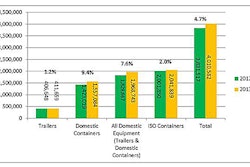Mountain View, Calif.—Nov. 6, 2013—SOASTA, a provider of cloud and mobile testing, announced the findings of its 2013 Holiday Retail Readiness survey, which revealed that even more Americans think stores should not put up Christmas decorations before Thanksgiving. In a survey of 2,038 Americans age 18 and older, in which data was weighted to be representative of the entire country, conducted online by Harris Interactive on behalf of SOASTA, discovered that 81 percent of American adults think stores should not play Christmas music before Thanksgiving—up from 78 percent of American adults when SOASTA conducted the survey last year.
In addition, 77 percent of American adults think stores shouldn’t put up Christmas decorations before Thanksgiving—up from 76 percent last year. Meanwhile, 78 percent of Americans feel stores should have a specific Cyber Monday website that can handle millions of people shopping for the holidays at once—up 75 percent from last year. And 75 percent of Americans feel that stores should have a dependable app(s) for smartphones that can easily handle mobile sales for the holidays—up from 73 percent last year.
“The results of our Holiday Retail Readiness Survey demonstrate a growing trend, that more and more Americans want retailers to focus on getting their websites and apps ready for the holiday rush instead of decorating for the holidays too early,” said Tom Lounibos, SOASTA CEO. “Last year, when we first conducted this research on ‘Christmas Creep,’ an overwhelming majority of Americans told us they want stores to focus on making sure their websites are ready for Cyber Monday and that their mobile apps are capable of handling the shopping demand. After the last holiday season, those percentages have only increased.”
SOASTA’s 2013 Holiday Retail Readiness Survey shows that 86 percent of Americans plan to shop online for the holidays this year, with the Northeast ranking first (89 percent) followed by the Western states (86 percent), South (85 percent) and Midwest (83 percent). The top anticipated online shoppers are men between the ages of 18 and 44 (93 percent). The demographics next most likely to be planning on online holiday shopping this year are women between the ages of 18 and 34 (89 percent), and men between ages 45 and 54 (89 percent). Overall, online shopping for the holidays was overwhelmingly popular with women ages 35 to 44 (87 percent), 45 to 54 (83 percent) and 55+ (79 percent). Online shopping was popular for men 45 to 54 (89 percent) and 55+ (81 percent).
The survey results come as SOASTA prepares many of the top online retailers for the busy holiday season by providing a mobile test automation solution that ensures websites and mobile apps work as planned, while catering to hundreds of thousands of concurrent users. SOASTA’s customers include Avaya, American Girl, Bonobos, Backcountry.com, Chegg, Experian, Gilt Groupe, Hallmark, Intuit, Microsoft and Netflix.
Survey Methodology
This survey was conducted online within the United States between October 28 and 30, 2013 among 2,038 adults (age 18 and over) by Harris Interactive on behalf of SOASTA via its Quick Query omnibus product. The 2012 survey was conducted online between September 17 and 19, 2012 among 2,346 adults. Figures for age, sex, race/ethnicity, education, region and household income were weighted where necessary to bring them into line with their actual proportions in the population. Propensity score weighting was used to adjust for respondents’ propensity to be online.
All sample surveys and polls, whether or not they use probability sampling, are subject to multiple sources of error, which are most often not possible to quantify or estimate, including sampling error, coverage error, error associated with nonresponse, error associated with question wording and response options, and post-survey weighting and adjustments. Therefore, Harris Interactive avoids the words “margin of error” as they are misleading. All that can be calculated are different possible sampling errors with different probabilities for pure, unweighted, random samples with 100 percent response rates. These are only theoretical because no published polls come close to this ideal.
Respondents for this survey were selected from among those who agreed to participate in Harris Interactive surveys. The data were weighted to reflect the composition of the adult population. Because the sample is based on those who agreed to participate in the Harris Interactive panel, no estimates of theoretical sampling error can be calculated.









